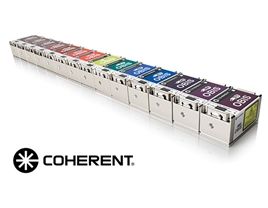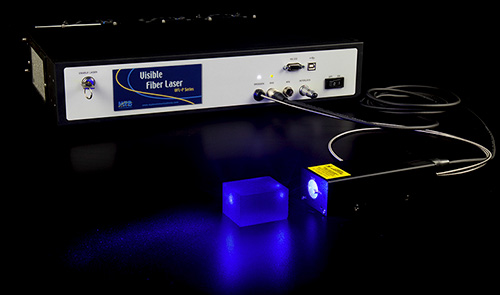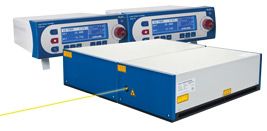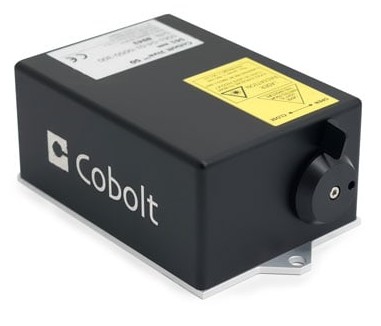blue lasers (original) (raw)
Definition: lasers emitting blue light
Category:  laser devices and laser physics
laser devices and laser physics
- lasers
- visible lasers
* red lasers
* yellow and orange lasers
* green lasers
* blue lasers
- visible lasers
Related: lasersgreen lasersred laserslaser diodesfrequency doublingultraviolet lasers
Page views in 12 months: 1140
DOI: 10.61835/ant Cite the article: BibTex BibLaTex plain textHTML Link to this page! LinkedIn
Content quality and neutrality are maintained according to our editorial policy.
📦 For purchasing blue lasers, use the RP Photonics Buyer's Guide — an expert-curated directory for finding all relevant suppliers, which also offers advanced purchasing assistance.
Contents
Lasers Emitting Blue or Violet Light
This article deals with lasers emitting in the blue and violet spectral region, i.e., with a wavelength roughly around 400–500 nm. Note that even lasers clearly emitting in the violet spectral region are often called blue lasers instead of violet lasers.
The choice of laser gain media for such wavelengths is limited, and the achievable performance is typically not as good as in, e.g., the infrared spectral region. However, substantial technical progress has led to a choice of blue and violet lasers, including many commercial devices, which is suitable for a wide range of applications.
Types of Blue Lasers
The following types of blue lasers are the most common:
- Blue laser diodes [4], based on gallium nitride (GaN) or related materials (e.g. InGaN) and emitting around 400–480 nm, have been developed quite successfully, now offering substantially better output powers and device lifetimes than green diode lasers. Output powers can now be up to the order of 10 W for a blue broad-area laser diode, for example, and by combining many of such laser diodes, fiber-coupled diode lasers with hundreds of watts or more out of one multimode fiber have become commercially available. One may also generate of the order of 100 W with a diode bar. Another development is that of blue-emitting VCSELs [11].
- Thulium-doped or praseodymium-doped upconversion lasers based on fibers or bulk crystals can emit around 480 nm, typically with some tens of milliwatts of output power and with good beam quality. Further development for powers of hundreds of milliwatts or even multiple watts appears to be feasible.
- Blue or violet light can also be generated by frequency doubling (external to the laser resonator or intracavity) the output of lasers emitting around 800–1000 nm. Most frequently used are neodymium-doped lasers, e.g. Nd:YAG emitting at 946 nm (for 473 nm), Nd:YVO4 at 914 nm (for 457 nm), and Nd:YAlO3 at 930 nm (for 465 nm). Common nonlinear crystal materials for frequency doubling with such lasers are LBO, BiB3O6 (BIBO), KNbO3, as well as periodically poled KTP and LiTaO3. Output powers of multiple watts can be obtained, even with single-frequency operation and high beam quality, although less easily than with 1-μm lasers. Instead of a laser, an optical parametric oscillator may be used.
- High-power optically pumped VECSELs are also very attractive laser sources for frequency doubling with several watts or even tens of watts of output power. Note that other kinds of semiconductor lasers, such as broad area laser diodes, are available with suitable wavelengths, but are less suitable for frequency doubling due to a typically broader linewidth and poor beam quality. There are some diode lasers, however, which deliver some tens of milliwatts of frequency-doubled light.
- helium–cadmium lasers (which are gas lasers) can emit hundreds of milliwatts in the blue region at 441.6 nm, with high beam quality.
- Argon ion lasers, based on laser amplification in an argon plasma (made with an electrical discharge), are fairly powerful light sources for various wavelengths. While the highest power can be achieved in green light at 514 nm, significant power levels of several watts are also available at 488 nm, apart from some weaker lines e.g. at 458, 477 and 497 nm. In any case, the power efficiency of such lasers is very poor, so that tens of kilowatts of electric power are required for multi-watt blue output, and the cooling system has corresponding dimensions. There are smaller tubes for air-cooled argon lasers, requiring hundreds of watts for generating some tens of milliwatts.
Eye Hazards
For wavelengths below ≈ 400 nm, the eye's sensitivity (i.e. its ability to detect small light levels) sharply declines, and one enters the region of ultraviolet light. (See also the article on ultraviolet lasers.) Note that even for wavelengths around or slightly above 400 nm, the retina can be damaged via photochemical effects even for intensity levels which are not perceived as very bright.
Applications of Blue and Violet Lasers
Blue and violet lasers are used e.g. in interferometers, for laser printing (e.g. exposure of printing plates) and digital photofinishing, data recording (Blu-ray Disc, holographic memory), in laser microscopy, in laser projection displays (as part of RGB sources), in flow cytometry, and for spectroscopic measurements. Direct diode laser applications also become increasingly feasible due to the performance enhancement of blue laser diodes.
Data recording is the major driver for the development of blue and violet laser diodes; the short emission wavelength allows for an improved density of storage.
In most cases, the use of blue and violet lasers is motivated by the relatively short wavelengths, which allows for strong absorption in many materials, for tight focusing, or for resolving very fine structures in imaging applications.
Frequently Asked Questions
This FAQ section was generated with AI based on the article content and has been reviewed by the article’s author (RP).
What is a blue or violet laser?
It is a laser that emits light in the blue or violet spectral region, corresponding to a wavelength of roughly 400 nm to 500 nm. Lasers emitting violet light are often simply called blue lasers.
What are the most common types of blue lasers?
The most common types include gallium nitride (GaN) based laser diodes, frequency-doubled solid-state lasers, upconversion lasers, and gas lasers such as helium–cadmium and argon–ion lasers.
How can blue light be generated from an infrared laser?
Blue light can be generated by frequency doubling the output of an infrared laser, for instance one based on a neodymium-doped crystal emitting around 900–1000 nm. This process uses a suitable nonlinear crystal to halve the wavelength.
What power levels can blue laser diodes reach?
A single broad-area blue laser diode can deliver around 10 W of output power. By combining many such diodes, fiber-coupled systems are available that produce hundreds of watts.
What are the main applications of blue and violet lasers?
They are used for high-density data recording like Blu-ray Discs, laser printing, microscopy, projection displays, flow cytometry, and spectroscopic measurements.
Why is the short wavelength of blue lasers useful?
The short wavelength allows for tighter focusing of the laser beam, which is essential for high-density data storage and for resolving very fine structures in imaging applications. It also leads to strong absorption in many materials.
Are blue lasers particularly dangerous for the eyes?
Yes, especially for wavelengths near 400 nm. The retina can suffer photochemical damage even at light intensities that are not perceived as being very bright.
Suppliers
Sponsored content: The RP Photonics Buyer's Guide contains 90 suppliers for blue lasers. Among them:
⚙ hardware
VEXLUM offers VECSEL technology with intracavity frequency doubling, producing diffraction-limited, watt-level lasers across the blue spectral region (400–500 nm). The lasers feature a wavelength tuning range of ±1 nm and a narrow linewidth, ideal for various applications:
Quantum technology:
- Rb Rydberg gates
- Ca+ state generation and cooling
- Sr 1st stage broad cooling
- Ba+ S1/2 → P1/2 cooling and detection
Semiconductor applications:
- Lithography and holography at specific wavelengths like 405 nm and 420 nm.
⚙ hardware
Edmund Optics offers blue lasers in the form of solid-state lasers from the Coherent OBIS™ series. Also, we provide violet and blue focusable laser diode modules that can be used as alignment lasers. Blue laser light can easily be filtered out when red or green light is used for illumination.
⚙ hardware
Osela's blue laser technology delivers superior resolution and depth of field for advanced machine vision applications. Operating in the 405–490 nm range, our blue lasers offer enhanced diffraction-limited performance, enabling the capture of fine details in inspection and measurement tasks. These lasers are particularly effective for applications requiring high precision, such as semiconductor inspection, 3D scanning, and particle analysis. Our blue laser modules can be tailored with various output powers and beam shapes, including line, dot, Top Hat and custom patterns, to optimize performance for specific imaging needs.
⚙ hardware
ALPHALAS offers actively and passively Q-switched diode-pumped solid-state lasers emitting blue light at 457 nm and 473 nm wavelengths. Typical parameters are pulse energy 1 … 5 µJ, pulse duration 1 ns, repetition rate 1 … 5 kHz. CW blue diode lasers with wavelengths 405 nm, 450 nm, 488 nm and up to 200 mW output power are also provided. The range of blue lasers is complemented with picosecond pulse blue diode lasers at wavelengths 375, 405 nm, 445, 450 and 488 nm.
⚙ hardware
MPBC offers continuous wave fiber lasers in the blue wavelength regime at up to 500 mW of output power in OEM or 2RU rack-mountable packages, allowing for easy integration or tabletop use. Fiber coupling options are also available. Exceptional performance is achieved based on the all-fiber architecture, which inherently ensures a narrow linewidth, diffraction-limited linearly polarized output with unprecedented wavelength stability.
MPBC is at the forefront of CW visible fiber lasers, having established collaborative relationships with researchers in the development of lasers for novel emerging applications.
⚙ hardware
Geola's BlueBird series pulsed lasers emit Gaussian TEM00 SLM radiation at 440 nm and are particularly designed for holography and scientific applications.
⚙ hardware
Serving North America, RPMC Lasers offers a selection of blue lasers including diodes and DPSS systems, from compact to high-power configs, in single-mode or multimode, free-space or fiber-coupled, customizable from components to turnkey setups.
High power up to 2 kW, short wavelengths, and high absorption in metals like copper enable small spot sizes, spatter-free welding, and efficient processing for industrial and scientific uses.
Optimized for holography, interferometry, and bio-imaging, they support high-resolution imaging, flow cytometry, surface measurements, LIBS, displays, and metal marking/cutting applications.
Let RPMC help you find the right laser today!
⚙ hardware
Sacher Lasertechnik has developed a frequency-doubled laser system where a resonant cavity including a frequency doubler crystal is pumped via a tunable diode laser. Depending on the required SHG power, the tunable diode laser is either a high power external cavity laser, or a two stage Master Oscillator Power Amplifier System. The covered wavelength regime ranges from 365 nm up to 540 nm.
⚙ hardware
Blue lasers from CNI include DPSS lasers (diode-pumped solid-state lasers) and diode lasers. The laser head comes with cooling and a precise temperature control system, and the power supply has overcurrent and overheating protection functions. CNI lasers exhibit stabilized output power, easy operation, reliable performance and long lifetime. The laser products include five series: high energy, high power, high stability, low noise and single longitudinal mode laser. Free space or fiber-coupled (SM fiber, MM fiber, homogenization fiber) versions are available.
⚙ hardware
HÜBNER Photonics specializes in high-quality blue and violet lasers, offering a range of specific wavelengths suitable for various applications. Our product lineup includes both diode lasers and diode-pumped solid-state lasers, as well as tunable laser options. Explore our offerings by wavelength:
For more detailed information on our products and to find the perfect laser solution for your needs, please visit our website.
Bibliography
| [1] | R. W. Wallace and S. E. Harris, “Oscillation and doubling of the 0.946-μm line in Nd3+:YAG”, Appl. Phys. Lett. 15, 111 (1969); doi:10.1063/1.1652925 |
|---|---|
| [2] | T. Hebert et al., “Blue and green CW upconversion lasing in Er:YLiF4”, Appl. Phys. Lett. 57, 1727 (1990); doi:10.1063/1.104048 |
| [3] | T. Hebert et al., “Blue continuous-pumped upconversion lasing in Tm:YLF”, Appl. Phys. Lett. 60, 2592 (1992); doi:10.1063/1.106919 |
| [4] | S. Nakamura et al., “InGaN-based multi-quantum-well-structure laser diodes”, Jpn. J. Appl. Phys. 35, L74 (1996) |
| [5] | D. G. Mathews et al., “Blue microchip laser fabricated from Nd:YAG and KNbO3”, Opt. Lett. 21 (3), 198 (1996); doi:10.1364/OL.21.000198 |
| [6] | R. Paschotta et al., “230 mW of blue light from a Tm-doped upconversion fibre laser”, JSTQE 3 (4), 1100 (1997); doi:10.1109/2944.649548 |
| [7] | M. Ghotbi et al., “High-average-power femtosecond pulse generation in the blue using BiB3O6”, Opt. Lett. 29 (21), 2530 (2004); doi:10.1364/OL.29.002530 |
| [8] | Z. Sun et al., “Generation of 4.3-W coherent blue light by frequency-tripling of a side-pumped Nd:YAG laser in LBO crystals”, “Opt. Express 12 (26), 6428 (2004)”; doi:10.1364/OPEX.12.006428 |
| [9] | M. Ghotbi and M. Ebrahim-Zadeh, “990 mW average power, 52% efficient, high-repetition-rate picosecond-pulse generation in the blue with BiB3O6”, Opt. Lett. 30 (24), 3395 (2005); doi:10.1364/OL.30.003395 |
| [10] | Q. H. Xue et al., “High-power efficient diode-pumped Nd:YVO4/LiB3O5 457 nm blue laser with 4.6 W of output power”, Opt. Lett. 31 (8), 1070 (2006); doi:10.1364/OL.31.001070 |
| [11] | T.-C. Lu et al., “CW lasing of current injection blue GaN-based vertical cavity surface emitting laser”, Appl. Phys. Lett. 92, 141102 (2008) |
| [12] | Z. Quan et al., “13.2 W laser-diode-pumped Nd:YVO4/LBO blue laser at 457 nm”, J. Opt. Soc. Am. B 26 (6), 1238 (2009); doi:10.1364/JOSAB.26.001238 |
| [13] | I. Akasaki, “Nobel Lecture: Fascinated journeys into blue light”, Rev. Mod. Phys. 87, 1119 (2015) |
| [14] | H. Amano, “Nobel Lecture: Growth of GaN on sapphire via low-temperature deposited buffer layer and realization of p-type GaN by Mg doping followed by low-energy electron beam irradiation”, Rev. Mod. Phys. 87, 1133 (2015) |
| [15] | S. Nakamura, “Nobel Lecture: Background story of the invention of efficient blue InGaN light emitting diodes”, Rev. Mod. Phys. 87, 1139 (2015) |
| [16] | W. Luhs and B. Wellegehausen, “Diode pumped cw ruby laser”, OSA Continuum 2 (1), 184 (2019); doi:10.1364/OSAC.2.000184 |
| [17] | J. N. Tinsley et al., “Watt-level blue light for precision spectroscopy, laser cooling and trapping of strontium and cadmium atoms”, Opt. Express 29 (16), 25462 (2021); doi:10.1364/OE.429898 |
| [18] | J. Hong et al., “All-fiber cyan laser at 491.5 nm”, Opt. Lett. 48 (5), 1327 (2023); doi:10.1364/OL.483830 |
(Suggest additional literature!)
Questions and Comments from Users
Here you can submit questions and comments. As far as they get accepted by the author, they will appear above this paragraph together with the author’s answer. The author will decide on acceptance based on certain criteria. Essentially, the issue must be of sufficiently broad interest.
Please do not enter personal data here. (See also our privacy declaration.) If you wish to receive personal feedback or consultancy from the author, please contact him, e.g. via e-mail.
By submitting the information, you give your consent to the potential publication of your inputs on our website according to our rules. (If you later retract your consent, we will delete those inputs.) As your inputs are first reviewed by the author, they may be published with some delay.



















